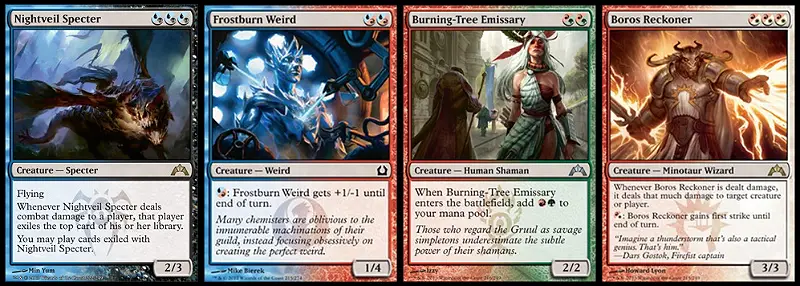
Some creatures have abilities that aren't fully explained on the cards. Most of these have reminder text that gives you a brief description of the ability's effect. Here are full explanations of the most common creature abilities:
Defender
Creatures with defender can't attack. They make excellent blockers and usually have high toughness.
Fear
A creature with fear can't be blocked except by artifact creatures and/or black creatures. Fear only matters when the creature with the ability is attacking.
First strike
Creatures with first strike deal their combat damage before creatures without it. When you reach the combat damage step, check to see if one or more creatures that are attacking or blocking have first strike. If so, an extra combat damage step is created just for them. The extra combat damage step works just like a normal one, except that creatures without first strike don't get to deal their combat damage.
When the first-strike combat damage step is over, you go through the normal combat damage step for the rest of the creatures-if they survived. (Some creatures even have an ability called double strike that allows them to deal damage twice-once during the first-strike combat damage step and once during the normal combat damage step).
Flying
A creature with flying can't be blocked by creatures without flying. Flying creatures can block other creatures with flying. They can also "swoop down" and block creatures without flying.
Haste
Creatures with haste can attack the turn they come under your control. You can also play their activated abilities with oT in the cost. In other words, a creature with haste can do the stuff it's normally not allowed to do during the turn it comes into play.
Landwalk
Landwalk is the name for a group of abilities that includes plainswalk, islandwalk, swampwalk, mountainwalk, and forestwalk. A creature with landwalk is unblockable if the defending player controls at least one land of the specified type.
Landwalk abilities don't cancel each other out. For example, let's say your creature with forestwalk attacks a player who controls a Forest. That player can't block your forestwalker at all-not even with another forestwalker.

Protection
Protection is an ability that protects a permanent from certain kinds of spells and abilities.
A creature with protection will always have "protection from _______". What's in the blank is what the creature is protected from. It might be protection from red, for example, or protection from white. Protection does several different things for the creature:
- All damage from sources of the color it's protected from is prevented.
- It can't be enchanted by Auras of the color it's protected from.
- It can't be blocked by creatures of the color it's protected from.
- It can't be the target of spells or abilities of the color it's protected from.
Protection isn't always tied to a color. For example, a creature could have "protection from artifacts" or "protection from Goblins".
Regeneration
Regeneration helps keep creatures from being destroyed. Regeneration effects work like shields. Once the regeneration spell or ability resolves, the effect hangs around waiting for the creature to be destroyed. If the creature would be destroyed, the effect saves the creature. (Regeneration is a replacement effect).
When a creature regenerates, it remains in play. So do any Auras, Equipment and counters on it. Three things do happen if a creature uses its regeneration shield:
- The creature becomes tapped.
- If it's in combat, it's removed from combat.
- All damage is removed from it.
Trample
Trample is a creature ability that lets the creature's extra damage be assigned to the defending player when it's blocked.
When a creature with trample is blocked, you have to deal at least enough of its combat damage to the creatures blocking it to destroy all those creatures. But you can assign any of its damage that's left over to the defending player.
Vigilance
Creatures with vigilance don't tap to attack. If you choose to attack with a creature that has vigilance, since that creature doesn't become tapped, you can use it as a blocker on your opponent's next turn.
Continue Reading


